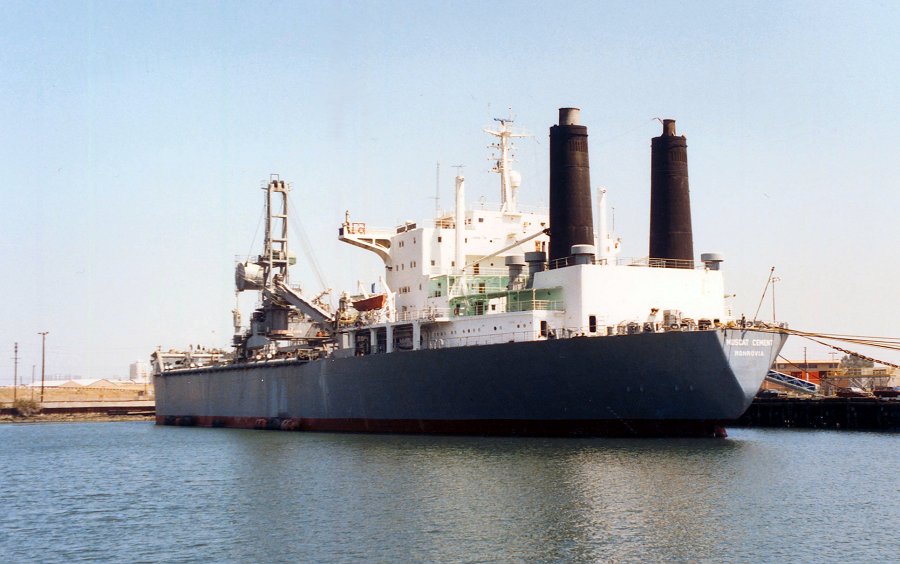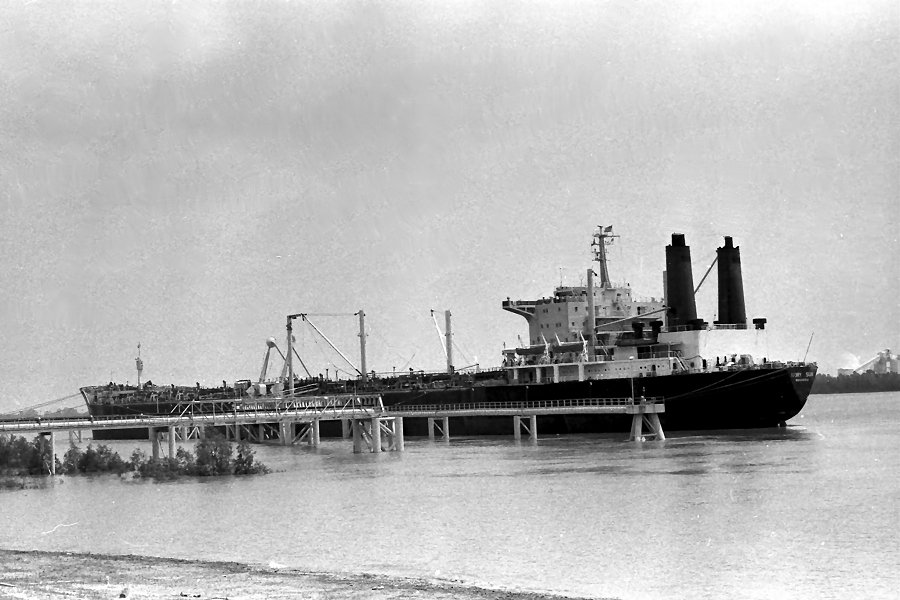Smaller Bulkers < 175.000 DWT Names A - M | home
Muscat Cement

"Muscat Cement".
( Photo Copyright Reserved )

"Muscat Cement".
( Photo Copyright Reserved )
The Miramar Ship Index for
|
FERNSTAR
|
IDNo / IMO
|
6803650
|
Year
|
1967
|
Name
|
FERNSTAR
|
Flag
|
NOR
|
Owner
|
A/S Glittre & D/S I/S Garonne
|
Type
|
Ore/oil carrier
|
Tons
|
55209
|
DWT
|
98543
|
LOA
|
254.7
|
LPP
|
245.4
|
Beam
|
39.0
|
Dept
|
??
|
Draft
|
??
|
Machinery
|
1D-15.5
|
kW
|
????
|
ShipDesign
|
Ore/oil carrier
|
Builder
|
Hitachi
|
Yard
|
Innoshima
|
Yard No
|
4135
|
Country built
|
JPN
|
Keel
|
30.06.1967
|
Launch
|
18.09.1967
|
Completed
|
28.11.1967
|
Subsequent History
|
1973 IVORY SUN - Kados Sg., Co., Ltd.
1978 APACHE - Fram Landinvest Inc.
1979 SKYROS - Skyros Sg., Corp.
1982 shortened 174.7 / 165.0 m, 24529 grt / 54749 dwt, converted to processing & cement storage vessel.
1981 MUSCAT CEMENT - Vistula Sg., Corp.
1993 HERACLES SPIRIT - Heracles Overseas Terminals SA
|
End
|
2000
|
Disposal Data
|
Scrapped Alang 31.05.2000. [ By Chaudhary Industries ] - work began 07.06.2000.
|
Los Angelos Times :
By TIM WATERS
MARCH 23, 1986 12 AM PT
TIMES STAFF WRITER
More than 3,200 ships sailed into the Port of Los Angeles last year. Most stayed two or three days before moving on.
Such is life in the shipping lanes.
Now consider the Muscat Cement, a 525-foot-long vessel that slipped into the port about eight weeks ago, sidled up to Berth 134 in Wilmington, shut off its motors and has been silent ever since.
Indeed, before the Muscat budges from its new berth, many motorists who see its giant gray hull from the Harbor Freeway will probably change cars or careers. Some will change spouses. Still others will have babies, grow rich or poor, move to other states or retire.
‘An Unusual Ship’
Through it all, the Muscat Cement, complete with a captain and crew, will remain anchored. The vessel isn’t going anywhere until at least 1991.
“It’s an unusual ship,” said Robert Smith, president of Pasadena-based Falcon Pacific Inc., which owns the Liberian-registered vessel. “To my knowledge, it’s the first time such a ship has been in the United States.”
Simply put, the vessel is a floating building that deals in one thing and one thing only--dry cement. It stores the cement in its own mammoth silo as it is unloaded from other ships, and then transfers it in bulk form or bags onto waiting trucks. The ship is equipped with machinery for bagging the cement.
Before the ship sailed to Los Angeles, it was in the Middle East, where such vessels have been used for years. “When OPEC started spending money like water there was a great need for cement, but there were no dock facilities to handle it,” said Paul St. Onge, a marketing specialist with the port.
Smith said his company was formed by its parent firm, Georgia-based Falcon Cement Co., expressly to operate the ship in Los Angeles. And, although the ship isn’t going anywhere soon, he said, a crew of about 20 will be aboard the vessel at all times, because Liberian law requires it. The sailors will maintain the vessel.
Delayed by Red Tape
Falcon had planned to have the ship in operation by now, Smith said, but has spent a great deal of time obtaining permits from a number of government entities, such as the South Coast Air Quality Management District. Falcon also is negotiating with four separate unions to work the ship, he said.
“It’s just a large piece of machinery to get moving,” Smith said. “You have to jump through a lot of hoops.”
Nevertheless, Smith is confident that the ship will start operations April 1 at its berth, which port officials said was not being used before Falcon signed a five-year contract. The port will earn more than $250,000 annually in wharfage fees and collect other fees based on the amount of cement the ship handles.
|